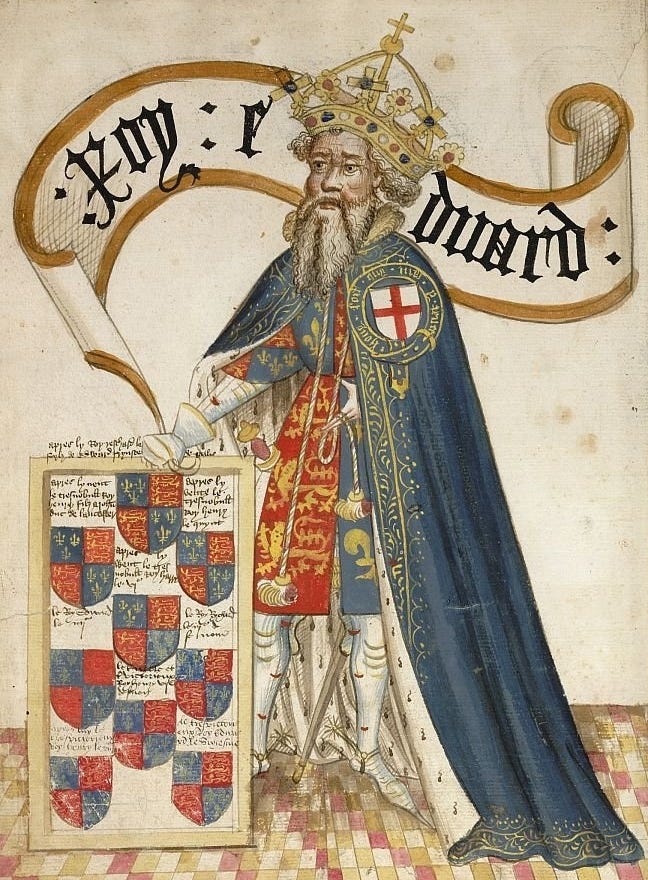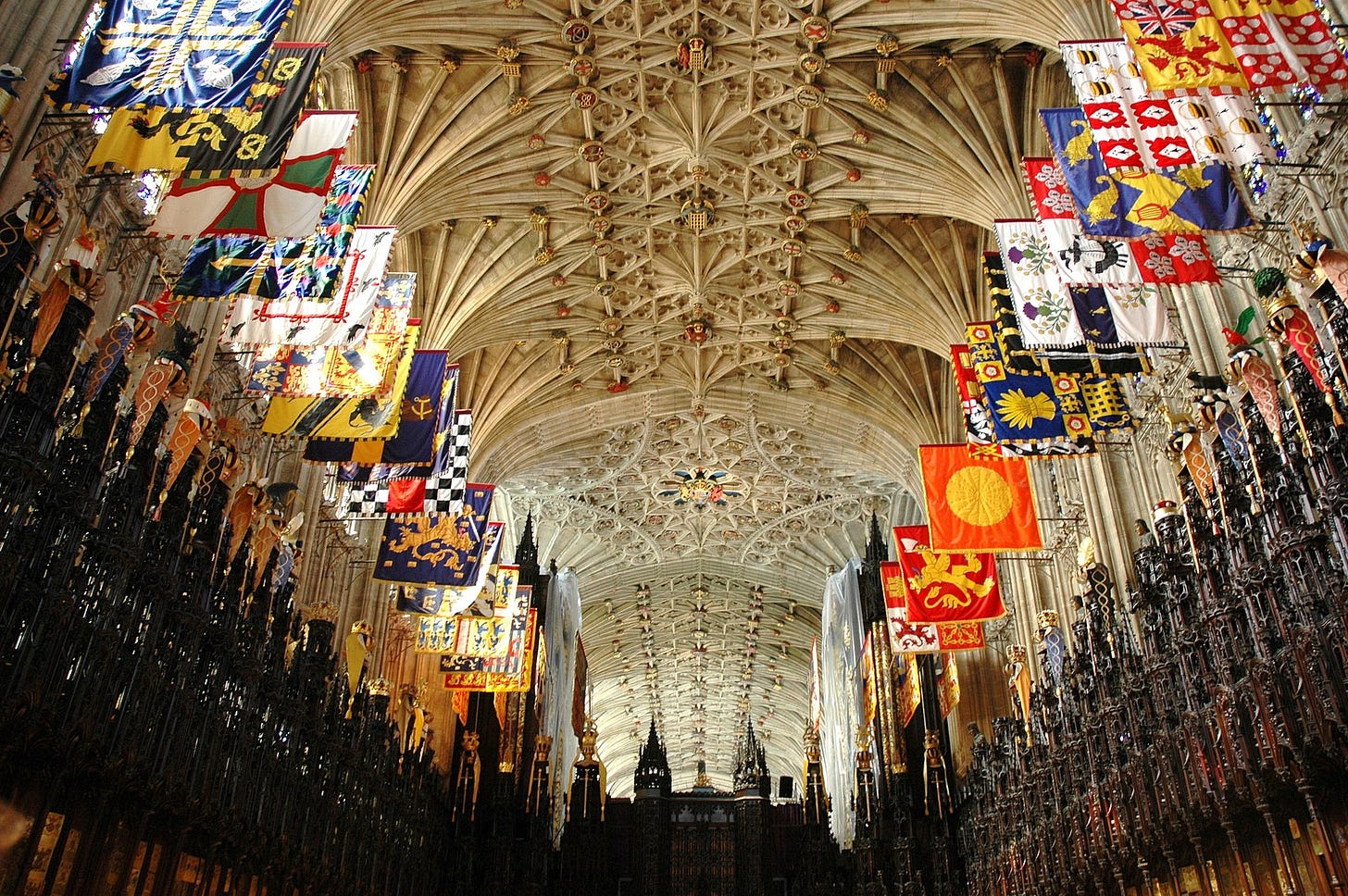#OTD in 1348, St George’s Day, Edward III founded the Order of the Garter. By doing so the king sought to identify himself, and his court, with the cult of chivalry. As an aggressive warrior-king, engaged in more or less constant military activity, Edward also sought to bind his knights via an organised confraternity or brotherhood.
Unlike earlier fraternities, such as the Knights Hospitaller and Knights Templar, the orders of chivalry were secular i.e. the members did not take monastic vows and were very much laymen. However, the religious ethos should not be underplayed: these chivalric orders also included brotherhoods of secular clergy whose role was to support the knightly members via prayer and ritual.
The Garter was not the only secular order of chivalry in the fourteenth century. It was preceded by the Order of the Band in Castile, and quickly followed (in 1351) by the less successful Order of the Star in France. Edward himself had tried to launch a previous brotherhood, in 1344, based on Arthurian themes of the Round Table. This plan came to nothing, undermined by intensive preparations for the French expedition of that year, but the spirit remained.
The actual foundation of the Garter is shrouded in mythology, which can be difficult to unpick. For instance, there is a later tradition that Edward founded the Order as a distraction from his illicit affair with an English noblewoman, identified in the sixteenth century as the Countess of Salisbury. This appears to be baseless. All we know for certain is that the knights of St George/the Garter came into existence sometime in 1347-1348, during a round of tournaments Edward held to celebrate his capture of Calais.
The Order might have dispersed soon afterwards, as many such fraternities did, when the euphoria of military victories had faded. However, after the 1348 tournament Edward took steps to place his new brotherhood on a more permanent footing. First, he founded a new college of secular priests to serve the fraternity feast, held at Windsor. At the same time he re-founded the Chapel of St Edward within Windsor Castle to give the Order a fixed headquarters.
Thirdly, Edward decreed the annual feast should be held on St George’s Day. Lastly, he chose a garter as the insignia of the Order, accompanied by the famous motto Honi soit qui mal y pense - “shame on him who evil thinks it.” The 'garter itself’ was probably not an article of women’s clothing - another later myth - but supposed to represent a miniature sword belt.
The first formal assembly of the new brotherhood took place at Windsor on 23 April 1349. Significantly, the special robes issued to Edward and his knights were blue, rather than the Plantagenet red; this probably signified Edward’s claim to the throne of France (the French royal colour was blue) and explains his reasons for founding a new brotherhood of knights at such a time, when the war was at its height.
In short, it was all part of a sustained propaganda campaign against his Valois cousins, exploiting the language and symbolism of chivalry to drive forward his war aims. Although the war Edward triggered ended in disaster, over a century later, few would have seen that coming in the afterglow of his great victories at Crécy and Calais.
Below, just for reference, is a helpful list of the twenty-six original Knights of the Garter:
King Edward III
Edward, the Black Prince (Prince of Wales)
Sir Henry of Grosmont, 1st Duke of Lancaster
Thomas de Beauchamp, 11th Earl of Warwick
Roger Mortimer, 2nd Earl of March
John de Lisle, 2nd Baron Lisle
Bartholomew Burghersh, 1st Baron Burghersh
John de Beauchamp, 1st Baron Beauchamp of Warwick
Ralph de Stafford, 1st Earl of Stafford
William de Montacute, 2nd Earl of Salisbury
Roger de Mortimer, 1st Earl of March
Sir John Chandos
James Audley (or Audeley)
Sir Otho Holland
Sir Henry Eam
Sir Sanchet D’Abrichecourt
Sir Walter Paveley
Sir Hugh Wrottesley
Sir Nele Loring
Sir John Grey
Sir John de Grailly, Captal de Buch
Sir Reginald Cobham, 1st Baron Cobham
Sir Thomas Ughtred
Sir Thomas Holland
Sir William FitzWaryne
Sir Miles Stapleton
Source: The Foundation and Early Development of the Order of the Garter in England, 1348-1399 by William Mark Ormrod






Ormrod said once that if he could have witnessed one moment from Edward III’s reign, it would have been the foundation of the Order of the Garter. He agreed too that the Garter represented a sword belt. To paraphrase him, the nearest we can get is Edward binding the great political and military actors of the day celebrating the great military victories of the day, but also in common obligation to the great enterprises.
The Order of the Garter was Edward’s distillation of an intoxicating form of chivalric kingship in miniature: a king, his great men in church and state, united together for governance and war. No wonder it has lasted down even to today.
Happy St George’s Day
Thank you. I'm intrigued by the history of this era and later. I've read dozens of books and can't seem to get enough. I appreciate this brief history of the Order.